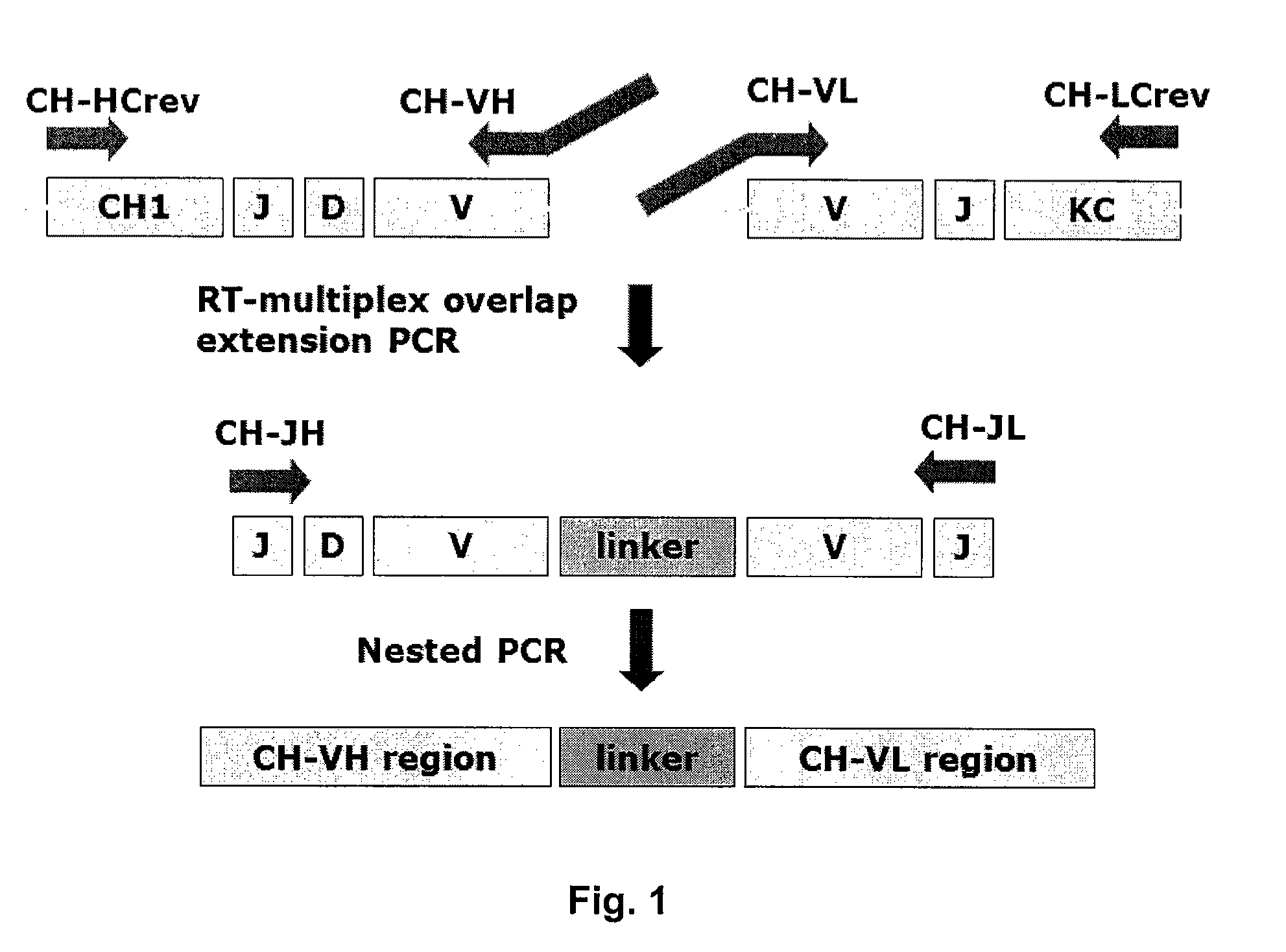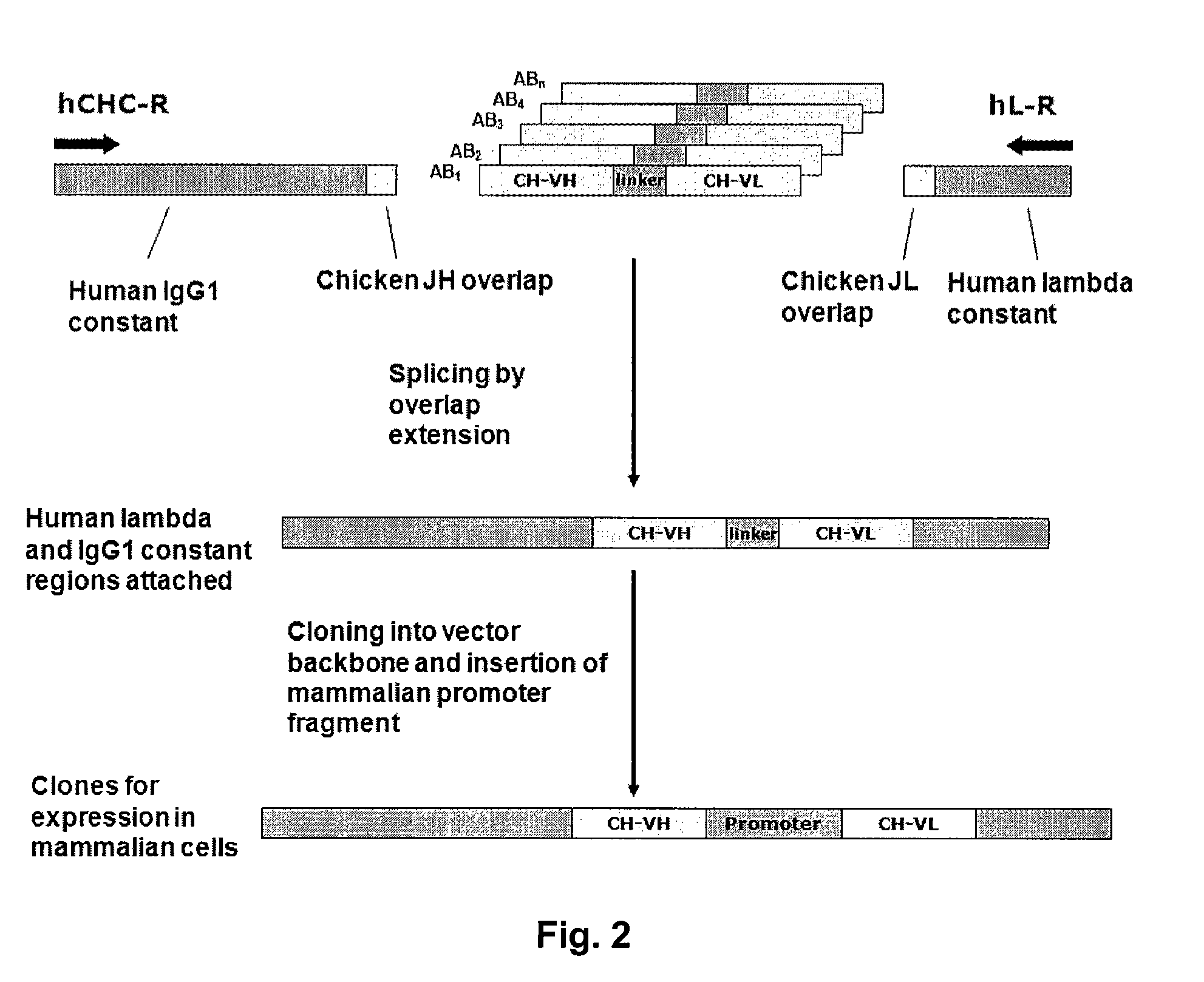Method for Cloning Avian-Derived Antibodies
a technology of avian-derived antibodies and cloning methods, which is applied in the field of cloning avian-derived antibodies, can solve the problems that documents do not address the issue of generating cognate pairs or combinatorial libraries, and achieve the effect of convenient sequence and/or inserting, and easy transfer
- Summary
- Abstract
- Description
- Claims
- Application Information
AI Technical Summary
Benefits of technology
Problems solved by technology
Method used
Image
Examples
example 1
[0240]This example demonstrates different gating and sorting strategies for isolation of antibody-producing B cells from chickens or hens, hereafter referred to simply as chickens (Gallus gallus; Isa Warren strain) by fluorochrome conjugated antibody staining and sorting of cells using fluorescence activated cell sorting (FACS) using a combination of lymphocyte specific cell surface markers. Bu-1 is a well-known specific chicken B cell surface antigen that is present on B cells during the maturation to antibody producing cells, and is lost during differentiation to plasma cells (Rothwell et al. (1996) Vet. Immunology Immunopathology 55:225-34). In addition, antibody-secreting cells were detected based on the presence of IgY at the cell surface. Despite the fact that cell surface presentation of IgY is lost during differentiation to plasma cells, this direct marker for antibody expression was included in the sorting strategy based on an assumption that the membrane level of IgY allow...
example 2
[0263]This example demonstrates that by the use of IgY-specific and TT-specific ELISpot assays the antibody-producing B cell populations can be identified among the sorted B cell populations in Example 1.
Solutions:
[0264]Washing buffer (1×PBS, 0.05% Tween):[0265]Blocking buffer: (RPMI, 2% skim milk)[0266]Complete RPMI: (RPMI, 10% Inactivated FCS, 1% P / S)
[0267]A PVDF-bottomed plate (Multiscreen-HTS, Millipore, MSIP S45 10) was coated with 100 μl anti-IgY antibody (Abcam ab 6872) or tetanus toxoid, both 10 μg / ml, diluted in PBS and incubated overnight at 4° C. Wells coated with PBS only were used as a negative control. The plates were washed 3 times in PBS and subsequently blocked with 200 μl blocking buffer at 4° C. for at least 2 hours. The buffer was then removed and replaced with 50 μl complete RPMI.
[0268]Ten thousand cells from populations 1, 4 and 7 (Example 1) were sorted in duplicate into the IgY, TT or PBS coated wells of the ELISpot plates. Two thousand IgY-posi...
example 3
Cloning of a Chimeric Chicken-Human Anti-Tetanus Toxoid Antibody Repertoire
[0271]Chicken spleen B cell populations P2 and P3 as described in Example 1 were single cell sorted as described above. For the use in Symplex™ PCR the cells were sorted directly into four 96-well PCR plates containing 10 μl buffer (Qiagen OneStep RT-PCR kit) and stored at −80° C. until the RT-PCR reactions were performed.
[0272]The chicken Symplex PCR amplification was performed on the four 96-well plates. The basic principles of the reactions are (FIGS. 1 and 2):[0273]First an RT reaction is performed in which heavy and light chain cDNA synthesis is primed by specific constant region primers.[0274]Secondly, a multiplex PCR reaction is performed using VH and VL 5′ region primers equipped with complementary overhangs facilitating the formation of connected VH and VL by overlap extension. 3′ primers are located in the constant region of the heavy and light chain sequences.[0275]A nested PCR reaction is performe...
PUM
| Property | Measurement | Unit |
|---|---|---|
| temperatures | aaaaa | aaaaa |
| temperatures | aaaaa | aaaaa |
| temperatures | aaaaa | aaaaa |
Abstract
Description
Claims
Application Information
 Login to View More
Login to View More - R&D
- Intellectual Property
- Life Sciences
- Materials
- Tech Scout
- Unparalleled Data Quality
- Higher Quality Content
- 60% Fewer Hallucinations
Browse by: Latest US Patents, China's latest patents, Technical Efficacy Thesaurus, Application Domain, Technology Topic, Popular Technical Reports.
© 2025 PatSnap. All rights reserved.Legal|Privacy policy|Modern Slavery Act Transparency Statement|Sitemap|About US| Contact US: help@patsnap.com



